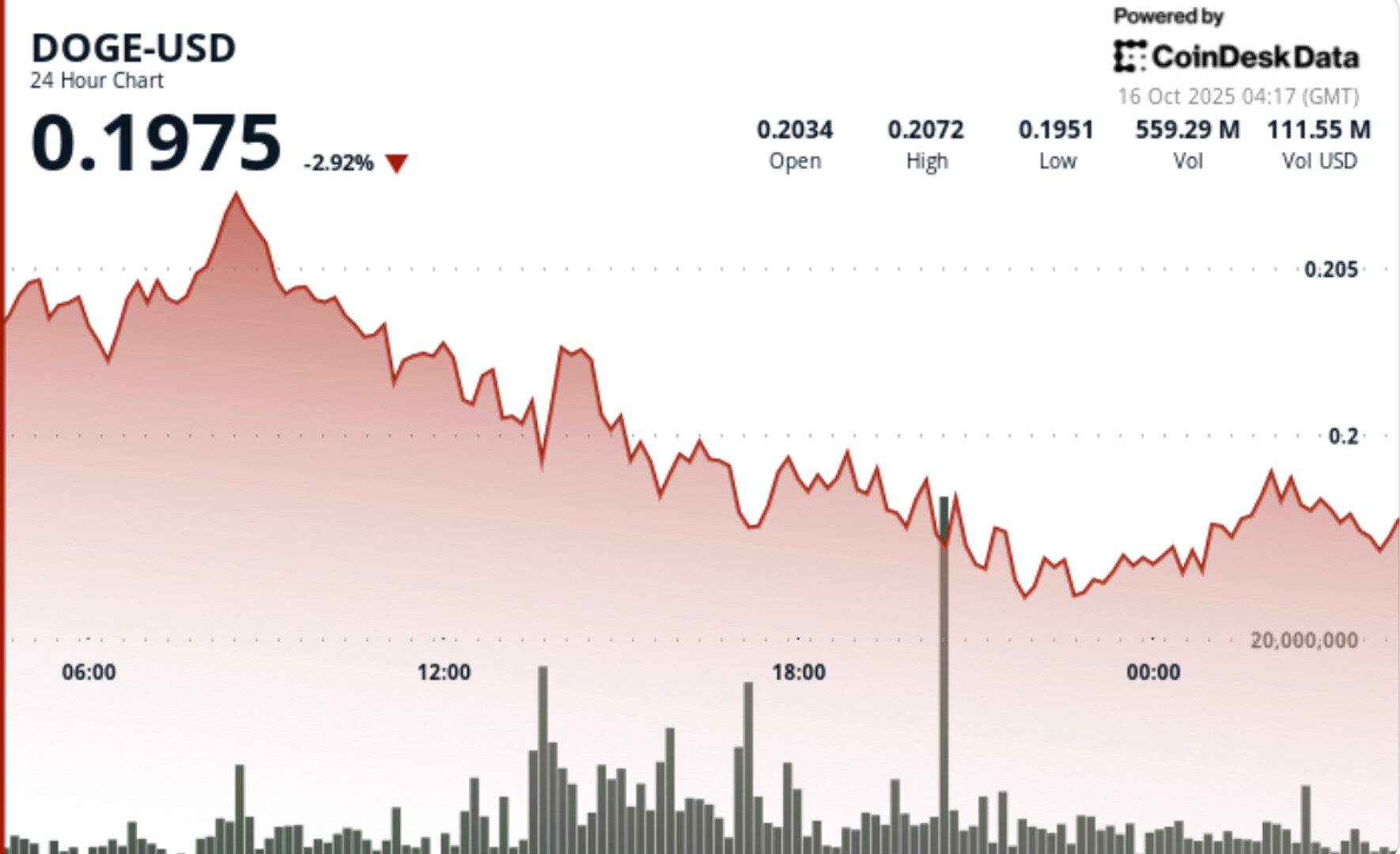Share this article
DOGE followed the broader market liquidation triggered by renewed U.S.–China tariff rhetoric, sliding 5% from $0.21 highs to settle at $0.20. President Trump’s proposed 100% tariff plan erased roughly $19B in crypto market value, sparking forced liquidations across majors.
By Shaurya Malwa, CD Analytics
Oct 16, 2025, 4:35 a.m.

- DOGE fell 5% amid heavy selling in the digital asset market, influenced by U.S.–China tariff tensions.
- Institutional interest is noted near the $0.20 level, despite broader market liquidations.
- The House of Doge’s Nasdaq debut supports long-term institutional interest, though short-term sentiment remains cautious.
Heavy selling across digital assets drives DOGE 5% lower; desks eye base formation as liquidation pressure shows early signs of exhaustion.
- DOGE followed the broader market liquidation triggered by renewed U.S.–China tariff rhetoric, sliding 5% from $0.21 highs to settle at $0.20. President Trump’s proposed 100% tariff plan erased roughly $19B in crypto market value, sparking forced liquidations across majors.
- Despite the selloff, institutional desks report accumulation interest near the $0.20 handle as derivatives open interest resets to mid-September levels.
- The House of Doge’s $50M Nasdaq debut through its Brag House Holdings merger continues to underpin long-term institutional narrative, though near-term flows remain risk-off.
- DOGE traded a $0.0117 (6%) range between $0.21 and $0.20 through Oct. 14 21:00–Oct. 15 20:00.
- Volume surged to 568.6M at 08:00 on the morning rally to $0.21 before sellers reclaimed control.
- Heaviest liquidation hit 13:00–15:00 window with 920M turnover as price broke below $0.21.
- Capitulation at 19:50 drove price to $0.20 lows on 12M volume, marking likely exhaustion.
- DOGE stabilized near $0.20 into close with reduced volume, hinting early demand return.
- Support remains firm around $0.20–$0.202, aligning with high-volume accumulation during liquidation troughs. Resistance stands at $0.21–$0.214, the zone capped by morning reversal volume.
- Short-term structure remains fragile while DOGE trades under the 200-day moving average, but volume compression and stable bid depth at $0.20 suggest potential base-building. A clean reclaim of $0.21 could invite momentum longs targeting $0.224–$0.228.
- Momentum indicators remain oversold; derivative funding turned sharply negative across Binance and OKX — conditions often preceding short-covering rallies.
- $0.20 support — whether bids absorb post-liquidation supply through Asia open.
- Volume follow-through on any $0.21 reclaim for confirmation of reversal.
- Institutional positioning around House of Doge’s Nasdaq-linked instruments.
- Broader risk sentiment around U.S.–China trade headlines.
More For You
Oct 10, 2025

Combined spot and derivatives volumes fell 17.5% in September, continuing a four-year seasonal trend
What to know:
- Trading activity falls 17.5% in September slowdown: Combined spot and derivatives volumes dropped to $8.12 trillion, marking the first decline after three months of growth. September has now seen reduced trading volume for the fourth consecutive year.
- Open interest reaches record high despite derivatives market share decline: Total open interest surged 3.2% to $204 billion and peaked at an all-time high of $230 billion during the month.
- Altcoins on CME outperform as Bitcoin and Ether futures decline: While CME’s total derivatives volume stayed flat at $287 billion (-0.08%), SOL futures jumped 57.1% to $13.5 billion and XRP futures rose 7.19% to $7.84 billion. BTC and ETH futures fell 4.05% and 17.9% respectively.
More For You
By Shaurya Malwa|Edited by Omkar Godbole
17 minutes ago

Researchers will focus on vulnerabilities that could threaten fund safety or protocol solvency.
What to know:
- Ripple is hosting a $200,000 “Attackathon” with Immunefi to test the XRPL Lending Protocol.
- The event invites white-hat hackers to find vulnerabilities in the protocol, which offers uncollateralized loans on the XRP Ledger.
- The XRPL Lending Protocol aims to bridge traditional credit markets with on-chain finance.











